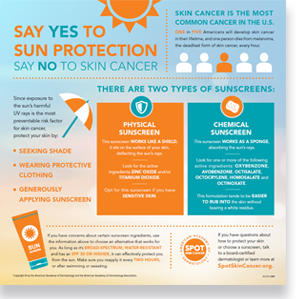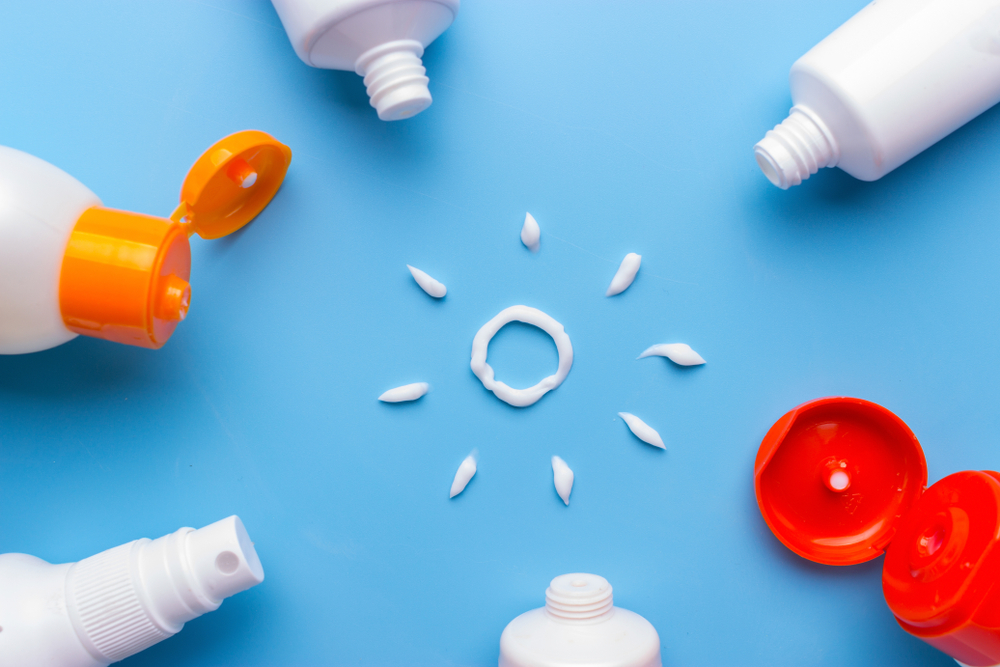Sunscreen has been in the news lately. Headlines, like Two-Thirds of Sunscreens Failing Safety Tests have provoked questions from our patients at our Southlake, Texas Dermatology practice. The soon-to-be-released report is expected to show that analysis of 1300 sunscreens (of the estimated 12,000) by the non-profit Environmental Working Group shows that more than half do not meet recently proposed FDA safety standards. With so many products on shelves throughout the Dallas marketplace, there is definitely a need to understand your doctor’s perspective on sunscreen. How does sunscreen use impact our health and the environment? How do we safely protect our skin from the harmful effects of UV rays?
Takeaway #1
It should be noted that the American Academy of Dermatology states that the risk of cancer or damage from the sun to unprotected skin is significantly worse than the potential damage caused by SPF chemicals. The EWG study found four sunscreen chemicals within the bloodstream 24 hours after application and this cause concern. It is important to know this study was very small (24 people) and sunscreen was applied 75% of the body (an unusually high surface area). The chemical causing the greatest concern within the blood was Oxybenzone.
While this recent report and updated FDA standards are ultimately leading to better consumer protection and product quality, best sun protection habits are often not clearly stated for the public.
Takeaway #2
When given a choice, choose a physical (mineral) sunscreen.
According to the American Academy of Dermatology:
Chemical sunscreens work like a sponge, absorbing the sun’s rays. They contain one or more of the following active ingredients, oxybenzone, avobenzone, octisalate, octocrylene, homosalate, or octinoxate. These sunscreens tend to be easier to rub into your skin without leaving a white residue.Physical sunscreens (also known as mineral sunscreens) act like a shield. Sitting on the surface of your skin, they deflect the sun’s rays. They contain the active ingredients zinc oxide or titanium dioxide. Ideally, one should look for a zinc level of 5% or higher.

Click to View Infographic: American Academy of Dermatology
At Greer Dermatology Southlake, all sun protection options contain zinc oxide and are also free of above-named, recently studied chemicals. The most “clean” option we recommend for highly sensitive skin and also for children is EltaMD Pure.
Many patients find that discussing options, including texture and color of the daily block, is helpful and choose to have our staff assist in suggestions.
Some fan favorites:
- EltaMD Clear (acne prone and men)
- EltaMD Pure (sensitive skin and children)
- EltaMD Daily Tinted (women)
- Revision Intellishade (tinted protection with added anti-aging)
Is Your Cell Phone Hurting Your Skin?
Another hot topic in skin care and dermatology today is the concern that blue light emitted from our modern technological devices is damaging our skin. Blue light is found most abundantly and naturally in visible daylight, along with UVA and UVB rays. Furthermore, blue light can be good for us. It helps regulate our sleep/wake cycles and helps with cognitive, memory, and mood issues.
However, recent research demonstrates that quite possibly there is evidence that blue light emitted by our devices (as well as the sun and indoor lighting) contributes not only to eye strain, cataracts, glaucoma, and other eye disease, but also to photo-aging, wrinkles, worsening skin tightness, and hyperpigmentation. Because we hold devices close to our face, physicians are seeing evidence of location-specific impact they identify as related to the use of cell phones.
In response, the cosmetic industry is rolling out numerous ‘blue-light’ blocking products. As with the previously cited study, more research is warranted and presently underway.
Takeaway #3
If you are a frequent user of cell phones or spend a lot of time in front of computer screens, there are steps you can take to protect your skin:
- Use a mineral-based physical sunscreen
- Pair a topical antioxidant (such as SkinCeuticals C&E Ferulic) with your morning sunscreen to help counteract the negative effect of blue light rays
- Lower the brightness index on your device screen or place electronics on “night shift” settings to remove blue light wavelengths
- Minimize facial exposure to damaging light by using voice-activated features and earbuds or headsets with your mobile phone
What’s the Best Sun-safe strategy for kids?
Infants
Sunscreen use is not recommended until 6 months of age. Prior to this time, it is best to use sun protective clothing, shade and avoidance of direct sun exposure.
- Avoid the hot midday sun between 10am and 2pm. Take walks in early mornings or evenings.
- Cover your baby with loose-fitting protective clothing and a sun hat. Many companies, such as UV Skinz, offer clothing options with UPF 50.
- Use your stroller’s canopy or hood to create shade and keep an umbrella in the stroller or car to be prepared.
Toddlers & Older Kids
- Apply an even layer of sunblock and reapply often, especially if your child is swimming, splashing or sweating. According to The American Academy of Pediatrics, one application for a child is equal to an ounce of sunscreen.
- If your child has sensitive skin, test any new sunscreen first by applying a small amount to the inside of the wrist at least one day prior to the day you plan to use it. That way you can avoid any irritation or rash and seek your dermatologist’s advice for other protection options, if necessary.
Takeaway #4
Always opt for a hat and shirt as the first line of protection against sunburn, and always use a safe and effective sunscreen. All it takes is for a child to sustain just a few blistering sunburns to double the chance of developing a serious form of skin cancer later in life.
Takeaway #5
If you have questions, ask your Southlake dermatologist about what is right for you! As always, Dr. Sara Greer and our entire team are available to answer any questions you may have about keeping your skin, and your family’s, health and protected. Don’t hesitate to reach out if you have questions or if you’d like to schedule an appointment. Call or Schedule Today

Dr. Sara Greer
For more information, read our Sun Protection Strategies article:
https://greerdermatology.com/family-sun-protection-strategies/

